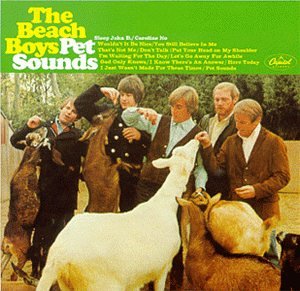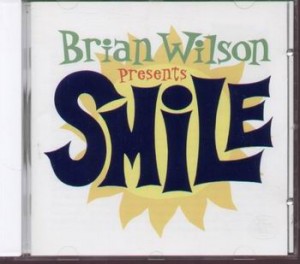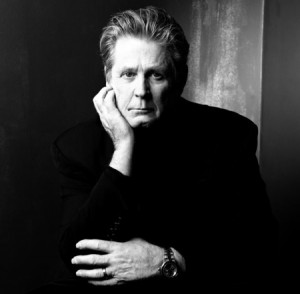FOREWORD: This online interview took place in ’04, when ex-Beach Boys icon, Brian Wilson, was promoting Smile, a long lost album he had never finished in the late ‘60s (due to drug usage and paranoia). It was followed up by ‘08s almost as good That Lucky Old Sun. This article originally appeared in Aquarian Weekly.
After the slow demise of early rockers Chuck Berry, Fats Domino, and Elvis Presley and the untimely deaths of Buddy Holly, Ritchie Valens, and the Big Bopper in a plane crash, the Beach Boys picked up the slack for a generation tired of sentimental teen idol drips.
In 1961, Hawthorne, California native Brian Wilson (lead vocals, bass, keys), younger brothers Carl (lead guitar) and Dennis (drums), plus cousin Mike Love (vocals) and local buddy Al Jardine (rhtyhm guitar) jumped to the forefront of the up-and-coming surf rock trend, releasing several wave ridin’ classics highlighting vulnerable angelic vocalizing.
Though early Beach Boys albums lacked pizzazz despite several wondrous singles, their ’62 debut, Surfin’ Safari (quickly made with some novelty songs), ’63 follow-ups Surfin’ USA (with its Chuck Berry-esque title track, hot rod classic “Shut Down,” and three instrumentals), Surfer Girl, and Little Deuce Coupe all contained magical moments.
A euphoric mix of George Gershwin’s theatrical whimsy and the Four Freshmen’s clean choir-like multi-harmonies inspired the close-knit quintet. Learning to structure chords from Burt Bacharach, Brian Wilson soon dove headfirst into the drug culture surrounding British Invasion bands and West Coast chart competitors the Mamas & the Papas, creating the thematic orchestral constructions of ’66 treasure Pet Sounds before literally freaking out.
 Nevertheless, Pet Sounds’ massive musical conceptualism and state-of-the-art studio design led the Beatles to greater heights and helped innovate the now-dreadful ‘rock opera’ trend defined by The Who’s vintage Tommy and Pretty Things lost-classic SF Sorrow.
Nevertheless, Pet Sounds’ massive musical conceptualism and state-of-the-art studio design led the Beatles to greater heights and helped innovate the now-dreadful ‘rock opera’ trend defined by The Who’s vintage Tommy and Pretty Things lost-classic SF Sorrow.
While the pioneering Beach Boys legend had already suffered from stage fright, this condition was exacerbated by terrible late ‘60s drug addiction.
After a nervous breakdown on a flight to a Houston show at age 24, Wilson retired from the Beach Boys as a touring member. Drug abuse brought on mental problems and Wilson struggled to complete his most ambitious project, Smile, because he didn’t like “where the music was coming from. We were taking a lot of drugs during that time and got carried away.” Though the unfinished album was shelved, the fascinating ‘pocket symphony’ “Good Vibrations” became a deserved chart topper.
Happily, Wilson returned in ’88 with a cherished eponymous solo record featuring the reverent ballad, “Love And Mercy.” Then in ’95, with old writing partner Van Dyke Parks, he collaborated on the enchanting Orange Crate Art. But no one could have expected what was to come next.
 In 2004, Wilson completed the elliptical Smile with Wondermints wunderkind Darian Sahanaja and an expansive orchestra. The result was, as Wilson said, “more progressive, happier, and uplifting.” Over forty years have past since the Beach Boys front man enjoyed his magnanimous glory days, but the twinkle in his eyes still reminds us all how the innocence he once had is not lost. And a world tour has brought lots of attention to Wilson.
In 2004, Wilson completed the elliptical Smile with Wondermints wunderkind Darian Sahanaja and an expansive orchestra. The result was, as Wilson said, “more progressive, happier, and uplifting.” Over forty years have past since the Beach Boys front man enjoyed his magnanimous glory days, but the twinkle in his eyes still reminds us all how the innocence he once had is not lost. And a world tour has brought lots of attention to Wilson.
Since Wilson is soft-spoken and terse answering questions, I added comments at the end of some of his responses to spice up the dialogue.
Who were some of your teenage influences inspiring the Beach Boys early recordings?
BRIAN WILSON: Rosemary Clooney, Chuck Berry, Phil Spector, and the Four Freshmen.
Where were you when you heard the Beach Boys’ first hit, “Surfin’,” on the radio?
BRIAN: I was in my living room with my family waiting for it to come on the radio. We all screamed in joy when it did.
In ’62, the Beach Boys and Four Seasons ruled the airwaves. What was it like when the British Invasion swept in and the Beatles and Rolling Stones became major competitors?
BRIAN: We were scared because we thought we were going to be eclipsed. So we got on the stick and made some good records.
Editorial remark: The Beach Boys responded with joyous ’64 #1 hit “I Get Around,” somberly mature brood “When I Grow Up (To Be A Man),” sassy #1 smash “Help Me Rhonda,” and sunny carnival-esque ode “California Girls.”
The Beach Boys covered Dick Dale’s “Let’s Go Trippin’.” Was he an influence?
BRIAN: He was an influence on Carl’s guitar playing. Yes, just Carl. He taught him a couple tricks on the guitar.
Dick Dale’s frenetic tremolo fretwork defined the sound of West Coast surf-rock, with its thunderously charging crescendos, wave-like flow, and breezy feel.
Was Duane Eddy’s twangin’ guitar style an influence as well?
BRIAN: No. Not an influence.
Corning, New York native Eddy became rock and roll’s biggest selling instrumentalist, creating “Rebel Rouser” in 1959, before similarly styled surf and hot road music became faddish.
Compare the ‘60s timeless pop music to that of today’s.
BRIAN: The ‘60s were much more creative, nice, and pleasant.
Though the competition was heavier on the charts, there are many Brain Wilson-influenced bands around nowadays that deserve exposure. All are subject to college radio’s limited scope since commercial radio sucks and payola scams rule.How has pop music changed since the ‘60s?
Commercial radio seems to play mostly compromised music presently. There are ridiculously talent-less American Idol crooners, hip-hop sell-outs, and fabricated punks galore.
BRAIN: (Radio) got better in the ‘70s and ‘80s. But it deteriorated in the ‘90s and now it’s nothing.
I’ve continuously argued that mainstream radio’s dismissal of punk a la the Ramones, Sex Pistols, and early Clash in ’77 ruined the kaleidoscopic range of the pop charts. Now, true Country crossovers, instrumentals, and other smaller genre fare never get sprinkled amongst the corporate rock and schlock pop slop.
What was it like to meet the Beatles? What did you discuss with them?
BRIAN: I met Paul and Ringo. Ringo was a funny person with a good sense of humor. Actually, Paul had a sense of humor, too. We talked about each other’s music.
Amazingly, the Beach Boys time-honored ’66 masterpiece, Pet Sounds, influenced the Beatles, the world’s biggest iconoclastic rock band ever, to undertake the technological magnum opus Sgt. Pepper’s Lonely Hearts Club Band. Not bad for a couple Cali homeboys.
Many of your songs deal directly or indirectly with God. What is your take on spirituality?
BRIAN: Spirituality is basic to music. You can’t separate the two. Music is spiritual.
I believe John Lennon once claimed “God Only Knows” was the Beach Boys best song. Though it’s a love song, there are hints of spirituality in its sincere, earnest tone. Several album tracks over the years point to Brian’s religiosity.
Was it initially difficult to capture Smile’s songs onstage because of their complexities?
BRIAN: No. The band is so good we duplicated the recordings.
The belatedly recorded and released album struck a chord with fans and critics alike, landing at #2 on the respected Village Voice Pazz & Jop Poll for ’04.
How’d you hook up with co-composer Darian Sahanaja?
BRIAN: I met him in a nightclub in Hollywood in 1997 with his band, the Wondermints. I asked them to be my backing band and the rest was history.
BRIAN: No. That’s not true.
I shouldn’t believe stupid internet rumors, but there you go…
Tell me about your upcoming Christmas album.
BRIAN: It’s eight standards, two new Brian Wilson songs, and two Beach Boys songs.
One of the Beach Boys tracks is a remake of “Little Saint Nick.” Bernie Taupin (ex-Elton John lyricist) lends “What I Really Want For Christmas” and famed writer Jimmy Webb tosses in a seasonal number.
What new gadgets and gear do you use that modern technology offers?
BRIAN: Pro Tools for sure. And we use some computers.
Luckily, these innovations may make it easier for Brian to compose future songs in the luxury of his own living room.
What ideas could you have explored better in the ‘60s if you had modern gear?
BRIAN: None. Because the records we made were perfect.
I’ll grant Brian that, but isn’t this the same man who’d labor over ideas forever, changing and rearranging chords so much that Smile didn’t see release until four decades hence. Well, maybe the drugs didn’t help.
Is it true it cost $100,000 to make the wand-like sound in the original “Good Vibrations”?
BRIAN: No. $15,000.
History always distorts the truth. But I wonder what English quintet the Tornadoes paid to record the oscillating synthesizer for turbo-charged ’60 instrumental, “Telstar.”
How’d your Live 8 performance in Berlin go? What songs did you perform?
BRIAN: Live 8 was fantastic. Did “God Only Knows,” “Do It Again,” “Don’t Worry Baby,” “California Girls,” and “Good Vibrations.”
Classics, every one, spanning his whole ‘60s career.
What new bands do you listen to these days?
BRIAN: I still listen to Paul Mc Cartney and Phil Spector (productions). That’s about it.
He should check out the former Elephant 6 collective. Start with Apples In Stereo and Neutral Milk Hotel.
Do you have any regrets?
BRIAN: I would never have taken LSD.
Rumors of Brian playing piano with his feet in a sandbox during the ‘70s ring true!
What artist would you have liked to work with but didn’t get a chance to?
BRIAN: Phil Spector.
…if Phil doesn’t go to jail for the mysterious shooting death of an ex-actress, there still may be time.
